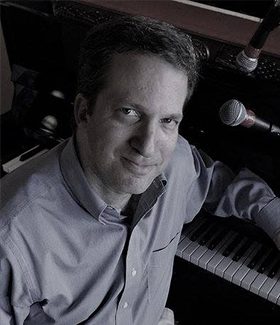Figge Partners With Many Quad-Cities Cultural Groups, Adds Online Programs For New Major Exhibit
Like its first blockbuster traveling exhibit of French art over two years ago, the Figge Art Museum again is partnering with many Q-C cultural organizations for its major new exhibit on American art.
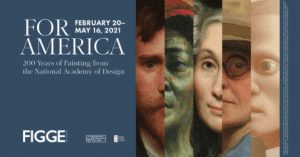
“For America: 200 Years of Painting from the National Academy of Design” will be at the Figge from Feb. 20 to May 16, at no additional charge.
Unlike the last one (partly due to the pesky pandemic now), the museum is offering a ton of virtual online content and programming, starting with a free Zoom celebration Thursday, Feb. 18 at 6:30 p.m. to preview “For America: 200 Years of Painting from the National Academy of Design.”
Figge executive director Michelle Hargrave will welcome National Academy of Design Director Gregory Wessner, and American Federation of Arts Director Pauline Willis. Plus, the Academy’s Director of Collections Diana Thompson, and Figge Assistant Curator Vanessa Sage will explore parallels between the Academy and Figge collections, and the origins of this exhibition.
“We have a lot of artists in our permanent collection that were or are National Academicians,” Hargrave said Wednesday. “In fact, we’re going to be identifying them in our permanent collection galleries.”
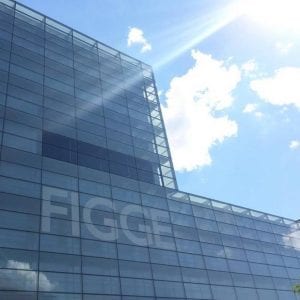
The Figge is at 225 W. 2nd St., Davenport and online at www.figgeartmuseum.org.
“They’ll be talking about some of the works in the Figge’s collection that were by those artists, as well as those in the National Academy’s collection, too,” she said.
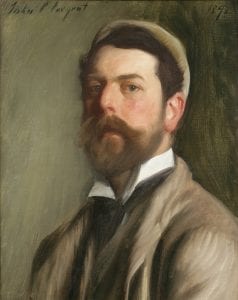
John Singer Sargent, Self-Portrait (1892), Oil on canvas, 21 x 17 in., National Academy of Design, New York, Courtesy American Federation of Arts
One of the strengths of the Figge collection is American art, including 19th century and Midwest Regionalist works (like Iowa’s Grant Wood), Hargrave said.
Founded in 1825 by the artist Samuel F. B. Morse and a group of forward-thinking individuals, the National Academy of Design has a simple yet powerful mission: to provide means for the training of artists and the promotion and exhibition of their art.
Since its founding, the Academy has upheld a rule from its first constitution: any elected National Academician must donate one of their artworks to the Academy’s collection. In 1839, the Academy decided that anyone nominated to the preceding rank of Associate National Academician must also present a portrait of themselves for the collection, whether painted by their own hand or that of a fellow artist.
Over the decades, these submissions have grown into a distinctive collection of American art that today includes nearly every major American artist. “For America” (its three-year national tour started in 2019 in Dayton, Ohio) is the first exhibition to highlight this pivotal aspect of the collection — the joint presentation of an artist’s portrait with his or her diploma work.

Ivan Albright, Self-Portrait (1948), Oil on canvas, 24 x 20 in., National Academy of Design, New York, Courtesy American Federation of Arts
Presenting nearly 100 artworks spanning over 200 years from 1809 to 2013, “For America” features masterpieces by revered American artists such as William Merritt Chase, John Singer Sargent, Cecilia Beaux, Charles White, Jaune Quick-to-See Smith, and many others.
The exhibition presents a unique history of American art as seen through the lens of artists. Exploring how these individuals have represented themselves and their country over time, the exhibition is a striking portrait of broadening diversity throughout the country’s history, according to the Figge.
“This is an incredible exhibition that explores our commonalities as well as our differences,” Hargrave said, noting it opens Saturday and Sunday to members only, then to the general public through May 16. “”It’s also an exceptional opportunity for dialogue and connection about what we all have in common: our country.”
It’s the second traveling blockbuster exhibit for the Figge, following “French Moderns: Monet to
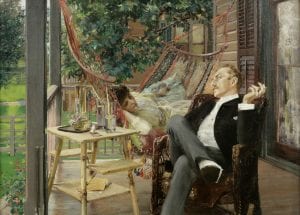
Robert Frederick Blum, Two Idlers (1888–89), Oil on canvas, 29 × 40 in., National Academy of Design, New York, Courtesy American Federation of Arts
Matisse, 1850-1950” – both made possible by a Major Exhibition Endowment Fund, which launched in 2016 and now sits at $1.3 million.
Between October 2018 and January 2019, “French Moderns” attracted 36,112 visitors to the Figge (225 W. 2nd St., Davenport), including people from 47 states and the District of Columbia.
The exhibit from New York City’s Brooklyn Museum included 60 paintings and sculptures by some of the world’s most famous artists, including Monet, Cezanne, Renoir, Matisse, Degas and Rodin. Thanks to the generosity of sponsors and donors, there was no additional charge to see it on top of regular Figge admission or membership, and that’s the same case with “For America.”
“French Moderns” really boosted giving to the endowment, which is meant to help the museum to bring in world-class art exhibits every other year in perpetuity, Hargrave said.
“I think people realized how important it is to bring those great works to he Quad-Cities and let people see them in person,” she said
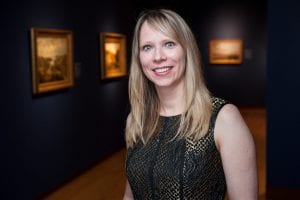
Michelle Hargrave is executive director of the Figge Art Museum.
Wednesday. “Everyone was so excited by that exhibition and it really inspired people to want to continue to do that.”
Despite a local and national economy devastated by Covid, they didn’t add an extra admission charge to “For America” because they wanted as many people as possible to see it, Hargrave said. “We’re truly lucky to be part of a community that understands the importance of the arts for a vibrant community.”
In addition to the Major Exhibition Endowment donors, the exhibit is sponsored by Estes Construction, Harris Family Charitable Gift Fund, US Bank, Alan and Julie Renken, Mark and Rita Bawden, and BITCO Insurance Companies.
The Figge also had an “Adopt-A-Painting” program to raise money for the new exhibit, with different tiers of donations. The donor could get their name on the painting label and receive an adoption certificate.
“We had a tremendous response to it,” Hargrave said of 55 people who participated. “It helps supports the programs and helped support bringing the exhibition here.”

The Figge is the sixth of eight museums in the U.S. to host the “For America” exhibit.
Figge members can come view the exhibit first (Saturday and Sunday) and see it as many times as they want, at no charge, Hargrave said, noting the Figge has about 1,300 members.
The museum will add a new micro website on Feb. 22 for the public to get a closeup 3D view of the exhibit, among other features. Online visitors can upload their own art; there will be fun activities, games, videos, and a calendar. There also will be secrets hidden throughout the tour, Hargrave said.
“It will allow people to have the experience of being in the galleries on their computer,” she said. “They can zoom in on artwork; they can read the labels; take a guided tour. So, we’re really excited about this opportunity.”
Of course, the Figge wants people to come in person to see the art. “There’s nothing like being in the galleries with the artwork,” Hargrave said. “Those that do feel safe can come to the museum, but if they do come to the museum, I hope they will spend time on the microsite and take advantage of the additional resources that are there. For those that don’t feel comfortable yet coming to the museum, this is a great way
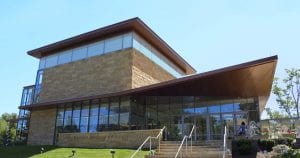
Michelle Hargrave was deputy director of the New Britain Museum of American Art in Connecticut from 2017 to 2019.
they can have that Figge experience safely from home.”
“This is the best time to come to the Figge; you don’t have the crowds,” she said, noting the museum caps attendance at 100 at a time in the building. “It’s an almost exclusive experience with the artwork – you won’t have people pushing you along, getting in your sight lines. It’s a great time to come see the exhibition in person and a safe time to come as well.”
The museum encourages but doesn’t require reservations.
During this time of social distancing, visiting the Figge offers a once-in-a-lifetime experience, Hargrave said. Sprawling across three floors and in adherence with the museum’s strict safety precautions that include capacity limits, visitors have the chance to view the exhibition without the hassle of crowds.
“There’s truly no better time to visit the Figge,” said Hargrave. “We’re so fortunate to have a facility with ample space that allows our visitors to safely view these masterworks.”
Looking back at the tour in Connecticut
The same exhibit was at Connecticut’s New Britain Museum of American Art (NBMAA) – where Hargrave worked before – from October 2019 to Jan. 26, 2020. She was deputy director at that museum for two years (starting at the Figge in early December 2019), and before that as curator at the American Federation of Arts, New York City, she organized dozens of exhibitions and spearheaded international and national partnerships.

Rosemarie Beck, Self-Portrait (1975), Oil on linen, 60 x 50 in., National Academy of Design, New York (Photo credit: Google), Courtesy of the Rosemarie Beck Foundation and American Federation of Arts
The Figge is the sixth museum of just eight to host “For America” during its national tour (which extends until January 2022).
“It was well-received and it resonated very much with the collection there,” Hargrave said of NBMAA. “One of the nice things about being later on in a tour is you can benefit from the experience of the preceding venues. One of the takeaways in New Britain was, many people are not familiar with the National Academy of Design.”
For the Figge, they modified the title to include “200 Years of Painting,” so people knew exactly what the exhibition was, she said. The other main difference was in 2019, of course, they didn’t have to deal with a pandemic, so they didn’t have virtual programming, Hargrave said.
“We’re having to be more creative and responsive at this time,” she said.
Guest scholars and experts did come to speak at NBMAA when the exhibit was there. “But what we have in the Quad-Cities is pretty unique,” Hargrave said. “The way the cultural and arts organizations come together, the libraries, universities, and so many organizations in the Quad-Cities, to come together to promote the exhibition and the exciting things happening here, it’s unique, extraordinary and just wonderful.”
The Figge had about 40 partners that worked on many programs complementing “French Moderns” and today there are 28 coordinating with the new exhibit, she said. They include the Quad City Symphony Orchestra, the Putnam, Ballet Quad Cities and Living Proof Exhibit. “It’s really exciting,” Hargrave said.
“It’s nice to have organizations working together in this way,” Hargrave said. “Each organization brings a unique perspective and highlights a unique aspect of history or art, related to the overall theme.”

John Frederick Kensett, The Bash-Bish (1855), Oil on canvas, 36 1/8 × 29 in.
National Academy of Design, New York, Bequest of James A. Suydam, 1865, Courtesy American Federation of Arts
A couple prime examples of related programming is with Q-C Symphony, which is offering American composers on programs Feb. 27 and April 10 – both available online with digital access for 30 days after those dates.
The Signature Series chamber-music concert Feb. 27 will feature American composers, including

Mark Russell Smith is music director and conductor of the Quad City Symphony.
multiple selections by Edgar Meyer and Mark O’Connor from their album “Appalachian Journey.”
The full orchestra Masterworks in April begins with Aaron Copland’s evocation of the spirit of rural Americana in “Appalachian Spring.” The Sphinx Quartet joins the QCSO for Michael Abels’s energetic combination of jazz, blues, bluegrass, and Latin dance in his “Delights and Dances.”
It concludes with selections from two distinctive works — the Fugue from Charles Ives’ epic Symphony No. 4 and “Chasqui” and “Coqueteos” from Gabriela Lena Frank’s “Leyendas: An Andean Walkabout.”
Among the multitude of museum companion programs for “For America,” the virtual “Art Meets Music” talk will be March 18 at 6:30 p.m. Hargrave and Mark Russell Smith, QCSO music director and conductor, will discuss the connection between American art and music. Like other virtual programs, registrants will receive a Zoom link two hours prior to the talk.
Virtual events galore
Since March is national Women’s History Month, Ranelle Knight-Lueth – a Coe College professor — will teach an online course on little-known women who worked behind the scenes and were instrumental in building America’s artistic scene. Those will be offered each Sunday

Vanessa Sage is assistant curator at the Figge.
in March (2:30-3:30 p.m.) on Zoom, $40 for Figge members, $55 for non-members.
She also will speak online March 4, sharing research on an influential woman in American art history — Leila Mechlin (1874-1949), an early and prominent member of the American Federation of Arts (AFA) and served as an art critic for the Washington Evening Star and Sunday Star newspapers.
Other virtual programming includes:
- Feb. 25 — Join recently retired Chief Curator Emerita Brandon Brame Fortune of the National Portrait Gallery, who will explore the role of portraiture through history during this exciting program that celebrates the exhibition.
- March 8 – A free Zoom event for members and $5 for non-members, join the Figge’s curatorial team as they discuss the planning and installation of a major traveling exhibition, followed by a Q&A.
- March 11 — Figge Assistant Curator Vanessa Sage will examine artists whose acts of self-determination changed the course of art. Registrants will receive a Zoom link two hours prior to the program.
- March 13 — March Free Family Day featuring an introduction to “For America.” Your free registration grants your family two weeks of access to a virtual lineup, which means you can choose your day to play!
- March 25 — Among the treasures of the National Academy of Design is Ferdinand Thomas Lee Boyle’s portrait of Eliza Greatorex, painted upon her election to the Academy in 1869. Join Katherine Manthorne for this fascinating lecture.
Building unity, community through art
The opening of “For America” is extraordinarily timely, as the journey through the exhibit reflects “significant cultural shifts in America that we continue to experience as a nation,” according to the Figge.

William Merritt Chase, The Young Orphan[or]An Idle Moment[or]Portrait (1884), Oil on canvas, 44 × 42 in., National Academy of Design, New York, Courtesy American Federation of Arts
The exhibition highlights shifts in figurative painting over the course of the last two centuries, revealing how individual artists balance subjectivity and objectivity. This framework offers viewers an intimate look into the minds of the artists while exploring a question that human beings have long wrestled with: how do we perceive ourselves and the world in which we live?
“This is an unprecedented look at the history of American painting—written by its makers. We’ve never seen anything like this before, and we’re honored to be hosting such an extraordinary exhibition at the Figge,” said Hargrave. “At a time when Americans are reflecting on all that unites us, this exhibition offers a glimpse into the lessons of the past that we can carry into the future with greater perspective.”
For America is organized into five sections, each reflecting continuing shifts in society, culture, and the state of art during the 19th- and 20th-centuries. The works on display encourage viewers to explore joys and hardships of American life through diverse artistic perspectives — ranging from Paul Sample’s painting of the unemployed during The Great Depression, to the expressively painted Snake Dance by Native American artist Jaune Quick-to-See Smith.
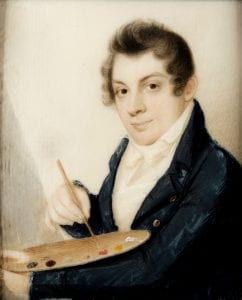
Samuel F. B. Morse, Self-Portrait, (c 1809), Watercolor on ivory, 3 ¼ x 2 ⅝ in., National Academy of Design, New York, Gift of Samuel P. Avery, John G. Brown, Thomas B. Clarke, Lockwood deForest, Daniel Huntington, James C. Nicoll, and Harry W. Watrous, 1900, Courtesy American Federation of Arts
For America urges viewers to see and appreciate the world through the eyes of others — in true American spirit — particularly as diversity has increased among the National Academy’s body of artist and architect Academicians. “Expressing the message that despite our differences, we’re all Americans, the exhibition is an effective display of unity that proves the healing power of art,” the museum said in a release.
A new work included here that wasn’t part of previous tours is by Kay WalkingStick (a Cherokee artist born in 1935) from 2009. She was elected to the National Academy of Design in 2018.
“It’s a beautiful painting comprising two panels, and she uses two surfaces to explore multiple points of view,” Hargrave said. “By incorporating designs and patterns from indigenous traditions into her landscape, she reclaims these lands and instills them with the indigenous identity that historical American painting traditions have largely erased.”
There were some other works added to the exhibit, including more contemporary art and by artists of color, she said.
The Figge’s total attendance in 2019 was a little over 86,000, and for 2020, they’re counting online and in-person participants, totaling between 70,000 and 80,000.
The Figge was closed to the public from mid-March 2020 to early June. It launched a virtual museum last spring at https://figgeartmuseum.org/visit/virtual-museum.
“We felt like it was important to continue to bring people and art together, serving our community,” Hargrave said.
Figge admission is $10 for adults, $6 for seniors, and $4 for children ages 4-12. Reservations are highly encouraged and can be made at www.figgeartmuseum.org, or by calling 563-345-6632.


